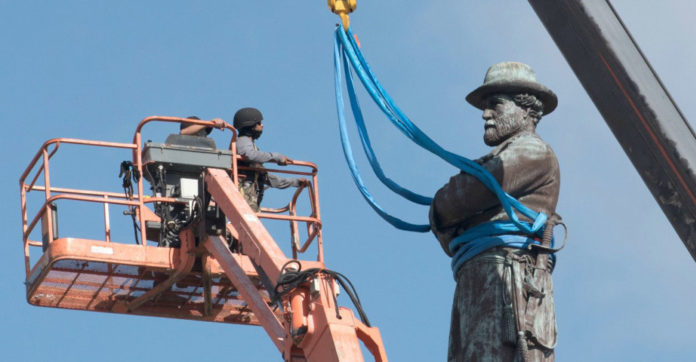On August 11, 2017, a group of white supremacists and neo-Nazi terrorists descended on Charlottesville, Virginia to (supposedly) protest the removal of a statue of Robert E. Lee. These protests ended with multiple injuries and the death of one counter-protestor. This violence has reignited the debate over what place (if any) these monuments have in today’s society. I believe that the only place that they have is in museums and here’s why:
History of the Confederacy:
The center of this debate revolves around the question of what the Civil War was actually about. Proponents of keeping Confederate paraphernalia on public land argue that the Civil War was largely a question of State’s Rights and not slavery. However, the historical record is pretty clear about the fact that the Civil War was about slavery. This is especially clear if you look at the Declaration of Causes of States Seceding, specifically the reasons given by South Carolina, the first state to secede. In this document, South Carolina specifically states that they are seceding because they believed that any attempts to abolish slavery were “hostile to the South” and “destructive of its beliefs and safety.” This was not just South Carolina either, Alexander H. Stephens, the Vice President of the Confederacy, states in the Cornerstone Speech of the Confederacy that “Our new government is founded upon exactly the opposite idea; its foundations are laid, its corner-stone rests, upon the great truth that the negro is not equal to the white man; that slavery subordination to the superior race is his natural and normal condition. This, our new government, is the first, in the history of the world, based upon this great physical, philosophical, and moral truth …” Stephens will also state in this speech that “They assume that the negro is equal, and hence conclude that he is entitled to equal privileges and rights with the white man. If their premises were correct, their conclusions would be logical and just but their premise being wrong, their whole argument fails.”
History of the Monuments:
Even if we ignore the history (which we definitely shouldn’t but let’s pretend for a second) and just talk about the statues, we still have problems that stem from why these statues were built. Contrary to popular belief, these statues were not built after the Civil War. Instead, a majority of them were built during the Jim Crow era in response to the Civil Rights Movement (See chart below).

Timeline of when Confederate Monuments were put up (Southern Poverty Law Center)
This fact indicates that these statues are not a product of an attempt to display “Southern Pride”, but they are in fact a direct attempt to honor the racist history of the Confederacy and to intimidate people of color. Now, looking at just what is going on with these statues now, we have some problems. The main problem is that actual neo-Nazis and Klansmen are marching in support of keeping these monuments in places like Charlottesville. This is not to say that everyone who wants to keep up Confederate statues is a Nazi (which would be an insane and untrue thing to say). Instead, it serves to highlight the fact that these statues are not designed to preserve history; they are instead designed with some kind of racist sentiment that draws in these people.
Counter-Arguments
The Statues are about Heritage, not Racism:
The fact that these statues were built in an attempt to intimidate people of color, specifically African Americans, during Jim Crow and as a response to the Civil Rights Movement, should show that they were not intended to actually honor culture. Now, even if we ignore that, let’s ask the question “Whose heritage do these statues celebrate?” The answer to this question is simple; they exclusively celebrate the heritage of white people and of white supremacy while ignoring the millions of African Americans who were brutalized under slavery and who suffered decades of oppression under the white supremacist Jim Crow laws. Now, if you are ok with having statues that promote this on your private property that is fine, but the foundation of our democracy relies on the notion that all people are equal under the law and public entities should not display objects that directly undermine this by alienation a large portion of the population.
What about X historical figures, they were racist too, are you just going to get rid of statues of them too:
This argument, promoted by our own president , implies that once we start removing statues honoring the Confederacy, then it will lead us down a road that will end with removing statues of figures like George Washington (since these figures also owned slaves). This argument is flawed for two reasons. First, it ignores the reasons that these figures are remembered. Washington, for example, is not remembered for creating a nation specifically so that he could still own slaves. Instead, Washington is remembered for his role in helping found our country and for leading it during its infancy. This stands in sharp contrast to people like Stonewall Jackson and Robert E. Lee who, to quote Jim Grossman, executive director of the American Historical Association, “were being honored for creating and defending the Confederacy, which existed for one reason, and that was to protect the right of people to own other people.” Second, this argument ignores the fact that leaders of the Confederacy are intrinsically linked to the white supremacy and oppression that comes with the Confederacy, while other historically figures, even those who owned slaves, have accomplishments that are not tied to these things.
If you take these statues down, you are erasing history:
First, museums and history books are a thing. These will not go away, so people will still know about the Civil War if we take down the Confederate statues. Also, most people (including myself) who argue for these statues to be taken down from public property believe that they should go to previously mentioned museums, so again, these statues will still exist and one could easily go see them if they were so inclined. This is in fact already happening, as we have seen in South Carolina and in New Orleans. Second, these statues are not really history. Instead, these statues honor an idealized view of the past which glorifies these traitors while whitewashing the atrocities of slavery which these men fought to maintain. Third, this argument immediately invites a question, which is, to quote Mayor Mitch Landrieu of New Orleans during a speech talking about the removal of New Orleans’ Confederate monuments, “why are there no slave ship monuments, no prominent markers on public land to remember the lynchings or the slave blocks; nothing to remember this long chapter of our lives; the pain, the sacrifice, the shame … all of it happening on the soil of New Orleans. So for those self-appointed defenders of history and the monuments, they are eerily silent on what amounts to this historical malfeasance, a lie by omission. There is a difference between remembrance of history and reverence of it. For America and New Orleans, it has been a long, winding road, marked by great tragedy and great triumph. But we cannot be afraid of our truth.”
This is just a big fuss for the sake of political correctness:
No, it’s not. It is instead an attempt to end governmental support for symbols that fetishize and glorify a traitorous government which was founded in order to maintain slavery and white supremacy.
So, why is this a big deal now?
I think that there are two reasons for this discussion happening now. I think the first is that these symbols honoring the Confederacy, from the flag to the statues, have been at the center of two major acts of domestic terrorism involving white supremacists.
The first is the 2015 attack on a black church by Dylan Roof, an act in which Roof will kill 9 unarmed African Americans who were attending a bible study. It was later discovered that Roof fetishized the Confederacy, to the point where he had posed with the Confederate battle flag in photos and traveled to Confederate heritage sites. The second attack was the one in Charlottesville, in which 32-year-old Heather Heyer was killed and 35 others were injured when a white supremacist (who was there to protest the removal of the statue of Robert E. Lee) rammed his car into a crowd of counter-protestors. These acts of terrorism have forced us to examine whether or not this iconography that these men glorify is, in fact, a good thing.
The second reason that this conversation is coming up now is because of America’s unfinished and ongoing discussion of race. Discussions of racial justice and protests from groups like Black Lives Matter, has prompted a critical reaction from some people, a reaction that commentators like Van Jones have called “whitelash.” Whitelash is, according to Jones, a term used to describe a backlash by white Americans against the growing successes and opportunities given to minorities.
Now, I want to be clear that I am not lumping all white people together here – and I am not saying that all white people “whitelash”. However, I also want to be clear that all white people do actually benefit from their historic and current position because of their race. Saying they benefit doesn’t mean that is the only way they have achieved stuff; however, an important part of the recent discussions of race is people trying to understand this relationship between their position and their experiences.
To understand this, an analogy from Arlie Hochschild, a sociologist and author of the (amazing) book Strangers in their Own Land would help. Hochschild talks about how certain groups in white America see themselves as being in the front of the line of prosperity. Now, this line’s progress has slowed down due to things like the stagnation of incomes and globalization, which has impacted these groups’ progress. Rather than blaming income stagnation and globalization, these groups feel like other groups, racial and ethnic minorities and women for example, are cutting the line to get ahead through new (and more equal) opportunities through anti-discrimination policies like affirmative action. This for these groups of white Americans explain their loss of position in line, not the real economic forces that are to blame. These white Americans are not being disenfranchised; rather, these other groups are now getting new (and more equal) opportunities through anti-discrimination policies like affirmative action. When you are privileged, as these white Americans have been through US history, you can (under some circumstances) see equality as oppression since you are so used to special treatment.
This relates to the monument debate because most vocal supporters of keeping these symbols feel like their history and identity is actually being threatened. And, they feel that they are being oppressed, when they are in fact members of the most privileged group – and that privilege remains intact where there are monuments or not.
Conclusion
In conclusion, confederate statues and the Confederacy in general have nothing to do with states rights. They are both instead focused on reinforcing and celebrating white supremacy and oppressing minorities. Due to this, we should take down these statues, we should place them in museums and place a sign under them that is inscribed with 1861-2017. We should use them as a teaching tool of a horrible past, not pretend that they are some kind of celebration of some fantastic bygone era. We also, to quote Mayor Landrieu again, “can’t wait any longer. We need to change. And we need to change now. No more waiting. This is not just about statues, this is about our attitudes and behavior as well. If we take these statues down and don’t change to become a more open and inclusive society this would have all been in vain.”
And to those who still support these statues, I ask you to engage in this hypothetical with me. I want you to think from the perspective of an African American parent trying to explain to his child who Robert E. Lee is and why there is a statue of him in the park. Can you honestly come up with a convincing explanation that’s positive? Do you honestly think that you can look them in the eyes and tell them that this was a great man whose statue is there to encourage them? Do you actually think that the story of Robert E. Lee fighting a war to keep their ancestors enslaved will encourage and inspire them? I am fairly confident that you don’t have good and honest answers to these questions. However, this should go to show that these statues are not welcoming to everyone and that maybe we should not have them in public places anymore.






